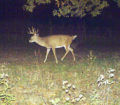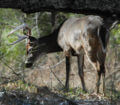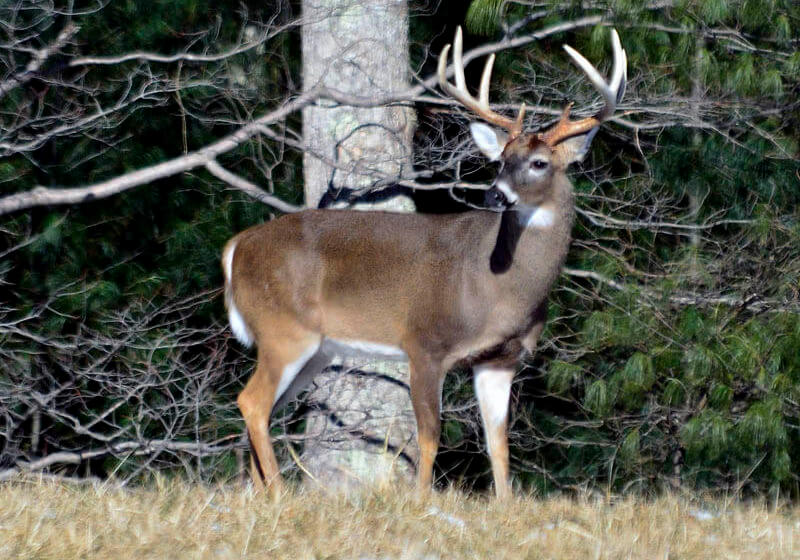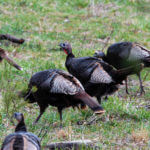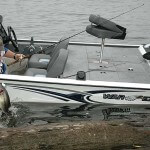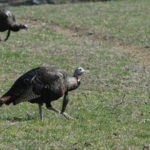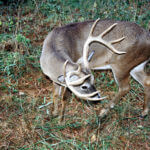Editor’s Note: Bob Walker of Livingston, Alabama, has guided for deer and turkeys for 28 years at Bent Creek Lodge (http://www.bentcreeklodge.com) in Jachin, Ala. He’s been deer hunting for more than 40 years. Walker knows how to find big bucks when he hunts faraway states from where he lives in places where no one is looking for them.
My secret to taking big bucks in other states is to find places to hunt that are overlooked by other hunters. Most hunters think that the more land they have to hunt, then the better their odds will be for taking trophy bucks. However, I’ve found the opposite is true. The smaller places you hunt where no one else is hunting often produce the biggest bucks. Many of these small plots become sanctuaries, if those sanctuaries have plenty of cover, food and water, or if the hunting land is extremely close to the sanctuary.
Walk the Boundary Lines to Find Small, Non-Pressured Deer Lands:
On my first trip to the Big Buck State of Illinois, I was as lost as a ball in high weeds. I didn’t know the property, and I didn’t know anyone who knew the property where I was to hunt. All I had was a map of this public-hunting area with the boundary lines drawn on it. When I hunt a new place, I don’t want to get off the property onto someone else’s land. So, when I got to this public-hunting region in Illinois a couple of days before the season, I took the boundary map and started walking the property line to learn exactly where I could and couldn’t hunt. I’ve learned over the years that often the boundary lines on a map aren’t exactly correct. For instance, if the boundary line of a public-hunting land is the edge of a creek, many times the public land may extend for 10, 20 or even 100 yards on the other side of the creek. The boundaries are usually marked with paint or signs on trees.
As I walked the edge of the creek of this public-hunting land in Illinois, I learned that the boundary of this public-hunting property had little pockets of land on the other side of the creek, although the map wasn’t marked like that. I thought, “Those little pockets of land on the other side of the creek probably get very little or no hunting pressure.” I also decided that since crossing the creek was difficult, that not many people would be willing to cross the creek to only hunt 50 to 100 yards of land from the creek to the true boundary line. Too, I could tell from where I had parked my truck that apparently, many other people had parked their vehicles close to this creek. I decided to park my truck about 200- to 300-yards down the road from where I entered the woods to keep anyone from knowing exactly where I started hunting.
When I went across the creek for the first time, I thought that the public-hunting land over there might only be a 50-yard stretch of hardwoods from the creek to the boundary line. But after walking the boundary line, I discovered that in some spots the boundary line was 200-yards beyond the creek. I found a place where a bend of the creek was close to private land. Sitting in my tree stand, I even could see houses not too far away. A gentleman was walking his dog, and I climbed down and spoke with him. He showed me a branch that came from the public-hunting land and went out into the soybean field – a vital piece of information. I learned that I needed to move my tree stand about 50-yards closer to the funnel than I had it set-up that day to be successful.
Once deer season started, I crossed the creek and put up my tree stand in the location I’d picked out. As the sun came up, I saw people coming out of their houses and starting their cars, headed to work. I spotted a number of deer coming out of the soybean field that morning and walking down that thick-covered ditch that came from the public land and went out into the soybean field. I could tell to be in the right spot to get a shot with my bow that I needed to move my tree stand one more time – closer to the ditch, which turned out to be a little creek. I picked out the tree where I wanted to put my stand, came out of the woods before lunch and hunted another place that afternoon. The following morning I crossed the creek again and moved my stand closer to the funnel and the thick- covered ditch that ran from the public land out into the soybean field. Just as the sun came up, I saw a huge 12-pointer following a doe down the ditch. He came to within 24 yards of my stand. I raised my PSE bow https://www.pse-archery.com/, came to full draw and shot the buck. That buck scored 160 points on Pope & Young.
I’ve learned that on many public-hunting areas, you may discover small patches of woods that are within the public-hunting area that don’t show-up on the map. There may be only an acre or less that’s not shown on the boundary map. Because these places are so small, most hunters won’t go to the effort to try to find and hunt them. Therefore, they become safe havens for mature bucks.
 Make Friends of Landowners:
Make Friends of Landowners:
The gentleman I’d met walking his dog who lived by the WMA property where I was hunting told me, “I have 45 acres of woods that adjoins this WMA where my family once lived, and I have some pastures for my cattle that surround that woodlot. Every day I see large numbers of does coming out in my pastures. Why don’t you hunt those woods and shoot some of those does?” I told him, “Well, thanks, but I’ve already got my deer. But if I come back next year, I’ll see you then, and if you don’t mind, I’d like to hunt those 45 acres of woods you have.”
The next season when I returned to Illinois, I planned to hunt the little creek where I’d taken the big 160-point buck the previous years. But that year had been super-dry in the area where I was hunting. Although I saw a few deer, because the creek had dried-up, my spot wasn’t as productive as it had been the year before. Then after my morning hunt, the wind changed, and I couldn’t hunt the spot I’d planned to hunt that afternoon. I went to see my dog-walking friend. “Let’s go see my 45 acres, and you can watch a pile of deer coming out of the 45 acres of hardwoods I told you about last year. They like to come to the little pond I’ve built for my cattle for water to drink.” Sure enough we saw 12 does come out of those hardwoods to drink the cattle pond’s water. Once again, my friend insisted I hunt his hardwoods. I explained that I didn’t want to impose. He said, “Why don’t you come back tomorrow in the middle of the day, let me take you around that little patch of woods and show you the deer sign that’s there?”
The next morning after I hunted the public land, I hurried to my new landowner friend’s property. We took his ATV and went across the 45-acre property that had been select-cut for timber 2-years earlier and had grown-up in a lot of brush and thick cover. That afternoon I saw 10 deer – one a small buck – coming out of those thickets and going to the pond to water. This hunt was in late October, and I knew the bucks should start rutting any day. I saw a large number of rubs and scrapes. I really got fired-up seeing all the buck sign. The next day I spotted some really-nice bucks, but they were still a little bit deeper in the woods than where I had put up my stand. I came out of my tree early, moved my stand again, set it up where I’d seen the bucks and then left the woods.
The next morning on my new friend’s 45 acres, I spotted a very big 8-pointer coming toward my tree stand. When he was at 27 yards, I drew my PSE bow, aimed right behind his shoulder and put the buck down. On this hunt, I learned that if you talk to people when you’re hunting public lands in faraway states, you’ll often discover a great spot to hunt that you’ve never known about, and that no one else ever has hunted.
 Identify Small Fingers of Woods on Public Lands:
Identify Small Fingers of Woods on Public Lands:
A friend and I decided to go to Kentucky and hunt a public-hunting area that was for bowhunting only. We got a map of this land and went to check the property out the day before bow season arrived. While we were driving around searching for the boundary lines, we saw this area had cornfields on both sides of it, with a small strip of hardwoods next to the road. I got my friend to take me back to the property line that divided the public-hunting area from the cornfield. I walked the property line that was wooded to try to find a place to hunt. I discovered this cornfield wasn’t as big as I thought it was – only about 8 acres. But I spotted a small finger of woods that was marked off as public-hunting land that ran out into the cornfield for about 100 to 150 yards. I scouted that little finger of woods and saw a tremendous amount of deer sign. I walked about 20-yards from the end of that little woodlot, looking for marks on trees where other hunters had put up tree stands and left candy wrappers, soft drink cans and/or cigarette butts on the ground or anything that would indicate that someone had hunted the small finger of woods that ran out in the middle of the cornfield. But I couldn’t find any hunter sign. I also saw there were two trees that had fallen from the edge of the corn field into the center of this little woodlot, creating a small funnel area that deer would have to walk through to move through the woodlot. That’s where I decided to put my tree stand.
I got into my tree the next morning before daylight, let the woods settle and heard deer moving through the corn. Just as I had enough light to see, I spotted does, a spike and a 6-point bedded about 20-yards from my tree stand. Too, other deer were walking through this little finger of woods. I heard a deer get up out in the corn and start coming toward my stand. When I could see him, he was a 138-inch 9-point buck. Once the buck came out of the corn, he walked straight to me. I had the wind in my face, so I knew he couldn’t smell me. The buck then turned to the right, and I placed the arrow behind his shoulder. The broadhead went through the kill zone and buried up in his off-shoulder. I heard him crash, and I followed the blood trail for about 65 yards and found the buck.
From this hunt, I relearned the value of walking the property lines on public-hunting areas. I also realized that most hunters wouldn’t want to hunt close to a WMA’s property line, thinking that the most and biggest deer were ganged-up in the middle of a public-hunting place. But I’ve discovered when you can locate one of those irregular property lines – like this little finger of woods that went out into the cornfield – often, you can take bucks other hunters never will see. These mature bucks have learned they can’t survive where hunters hunt, but they can survive in little woodlots or thick-cover areas where hunters don’t hunt.
 Check Out Abandoned Railroad Tracks:
Check Out Abandoned Railroad Tracks:
This hunt took place in Illinois on public-hunting land. I walked the property lines of this WMA in regions where I hadn’t checked before. One of the boundaries was an abandoned railroad track I walked. I probably walked a little over 1-1/2-miles down the railroad track, until I came to a trestle that went over a small creek. About 10 acres of thick-cover public land was on the other side of the railroad track that was CRP (Conservation Reserve Program) land. I decided to investigate those 10 acres. A little creek was between two hills, and then on top of one hill was a cornfield. The bottom was so grown-up with vegetation that I hardly could see the signs that marked the boundary of the public-hunting property. As I stomped through that thick cover, I heard a deer get up and run-off. I kept looking, but I couldn’t figure out how the deer were coming into the thicket where apparently they were bedding.
When I got down to the creek, the creek was too wide for me to cross. I followed the creek back to the railroad tracks. I was going to climb up the bank, walk across the trestle and go down on the other side of the creek. But once I arrived at the trestle, across the creek I spotted a well-defined deer trail that went under the railroad trestle. I looked for trees where I could put up a tree stand but couldn’t see any. I climbed up the bank, walked across the trestle and investigated that side of the creek. I saw that the land on the opposite of the creek from where I had started scouting was much flatter than the land on the other side of the creek, including a flat creekbank that went under the trestle, providing easy access for the deer to go under the trestle and get into the other woods.
I went back to the other side of the trestle where there was riprap on the edge of the creek. I got some sticks and limbs and pushed some of those big rocks up and made myself a little blind on the opposite side of the creek from the deer trail that went under the trestle. Later I spotted a doe come out from under the trestle from that big block of public-hunting land on the opposite side of the trestle from where I was hunting but never did see a buck. The trestle was to my right, and the deer trail was to my left. Then I heard a deer coming down the trail headed toward the trestle. I thought it probably was the doe that had come under the trestle earlier. I figured she had turned around to return to the big block of woods on the other side of the railroad tracks. But a huge buck with big, heavy antlers came down the trail headed right for the trestle. I came to full draw, aimed and grunted with my mouth. The buck stopped and looked up, just as I released the arrow. When the buck took the arrow, he jumped-up, wheeled around and started running back the way he had come. I grunted again. The buck stopped, stood still for about 10 seconds and then fell over. This buck was a 12-point that scored 141 on Pope & Young.
I learned once again that some really nice bucks can be found on or near small places in public-hunting areas. My secret to finding those bucks was to walk what everyone believed was the property line and search for those small, offset thick-cover places that only might be 10 or 20 acres but were still part of the public-hunting land. These small spots generally didn’t show up on the maps as public-hunting regions. But once you’ve identified those spots, they’ll be marked as a part of the public-hunting property.
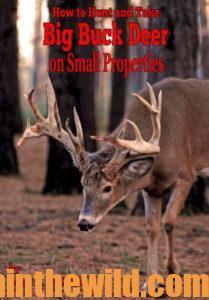
 To learn more about deer hunting, go to John E. Phillips’ books and learn the tactics small property owners have used successfully by checking out John E. Phillips’s book, “How to Hunt and Take Big Buck Deer on Small Properties” at https://www.amazon.com/dp/B00OOC2T0Y#, available in Kindle, print and Audible versions. To receive your free book on “How to Make Venison Jerky,” go to https://www.emailmeform.com/builder/form/Ece3UZVcOo52cKPJcL.
To learn more about deer hunting, go to John E. Phillips’ books and learn the tactics small property owners have used successfully by checking out John E. Phillips’s book, “How to Hunt and Take Big Buck Deer on Small Properties” at https://www.amazon.com/dp/B00OOC2T0Y#, available in Kindle, print and Audible versions. To receive your free book on “How to Make Venison Jerky,” go to https://www.emailmeform.com/builder/form/Ece3UZVcOo52cKPJcL.

